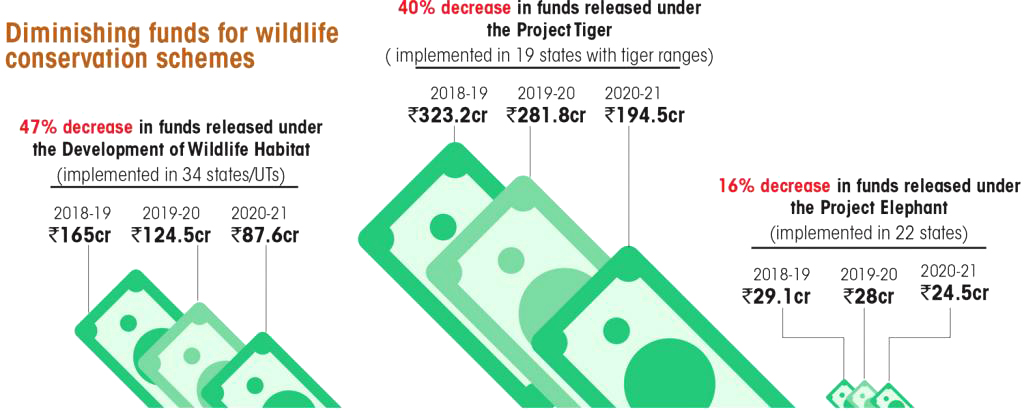Biodiversity & Environment
World Wildlife Day
- 05 Mar 2022
- 6 min read
For Prelims: World Wildlife Day, Convention on International Trade in Endangered Species, Sustainable Development Goals, Wildlife (Protection) Act, 1972, Environment Protection Act, 1986, The Biological Diversity Act, 2002
For Mains: Importance of conserving Wildlife, India’s Domestic Legal Framework for Wildlife Conservation.
Why in News?
World Wildlife Day has been celebrated every year on the 3rd of March since 2013.
- The date chosen coincides with the day of the Convention on International Trade in Endangered Species of Wild Fauna and Flora (CITES) which was signed in 1973.
- The UNGA (General Assembly) resolution also designated the CITES Secretariat as the facilitator for the global observance of this special day for wildlife on the UN (United Nations) calendar.
What is the theme of 2022?
- Theme: Recovering key species for ecosystem restoration.
- This theme is chosen as a way to draw attention to the conservation status of some of the most critically endangered species of wild fauna and flora.
What is the Significance of the Day?
- This aligns with UN Sustainable Development Goals 1, 12, 14 and 15, and their wide-ranging commitments on alleviating poverty, ensuring sustainable use of resources, and on conserving life both on land and below water to halt biodiversity loss.
- Our planet is currently facing the urgent challenge that is the loss of biodiversity and up to a million species could disappear in the coming decades if unsustainable human activity, climate change and habitat degradation are left unchecked.
What about the Status of Species of Fauna and Flora?
- Around more than 8000 species of wild fauna and flora are endangered and close to 30,000 more are known to be on the verge of getting extinct or vulnerable.
- It is also estimated that around a million species are extinct.
- India accounts for 7-8% of all recorded species, including over 45,000 species of plants and 91,000 species of animals.
- India is one of the most biodiverse regions of the world, home to three biodiversity hotspots - the Western Ghats, the Eastern Himalayas, and the Indo-Burma hotspot.
- The country has seven natural World Heritage Sites, eleven Biosphere Reserves and forty nine Ramsar sites.
- India is home to a number of wildlife conservation parks and sanctuaries, notable among those are Jim Corbett National Park in Uttarakhand, Ranthambore National Park in Rajasthan, Gir National Park in Gujarat, Bannerghatta Biological Park in Karnataka, Periyar National Park in Kerala, Hemis National Park in Ladakh, The Great Himalayan National Park in Himachal Pradesh.
- The main factors that contribute to the extinction of species include human activities such as habitat loss due to urbanisation, overexploitation, moving species from their natural habitat, global pollution and climate change.
- Illegal wildlife trade is also unsustainable, harming wild populations of animals and plants and pushing endangered species toward extinction. It also brings several public health consequences, such as the spreading of zoonotic pathogens.
What about India’s Domestic Legal Framework for Wildlife Conservation?
- Constitutional Provisions for Wildlife:
- By the 42nd Amendment Act 1976 of the Constitution "Forests" was added as Entry 17A in the Concurrent List and the "protection of wild animals and birds" was added as Entry 17B.
- Article 51 A (g) of the Constitution states that it shall be the fundamental duty of every citizen to protect and improve the natural environment including forests and Wildlife.
- Article 48 A in the Directive Principles of State policy, mandates that the State shall endeavor to protect and improve the environment and to safeguard the forests and wildlife of the country.
- Legal Framework:
- India’s Collaboration With Global Wildlife Conservation Efforts:
- Convention on International Trade in Endangered Species of Wild Fauna and Flora (CITES)
- Convention on the Conservation of Migratory Species of Wild Animals (CMS)
- Convention on Biological Diversity (CBD)
- World Heritage Convention
- Ramsar Convention
- The Wildlife Trade Monitoring Network (TRAFFIC)
- United Nations Forum on Forests (UNFF)
- International Whaling Commission (IWC)
- International Union for Conservation of Nature (IUCN)
- Global Tiger Forum (GTF)
PYQ
The most important strategy for the conservation of biodiversity together with traditional human life is the establishment of (2014)
(a) biosphere reserves
(b) botanical gardens
(c) national parks
(d) wildlife sanctuaries
Ans: (a)







